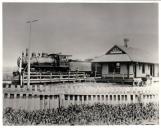14
TH&B: In Service
20th Century, Circa 1900
Jerseyville Train Station, Jerseyville, Ontario, Canada
 Credits:
Credits:
Westfield Heritage Village Collection
15
TH&B: In Service
26 September 1924
Jerseyville Train Station, Jerseyville, Ontario, Canada
 Credits:
Credits:
Westfield Heritage Village Collection
16
TH&B: In Service
28 March 1928
Jerseyville Train Station, Jerseyville, Ontario, Canada
 Credits:
Credits:
Westfield Heritage Village Collection
17
For the first three or four years of its life, the TH&B railway was mainly a passenger line. However, the company knew it couldn't survive on passenger travel alone, and so looked for ways to expand itself into the freight carrying business. In 1899, the TH&B began constructing what was known as the "Belt Line". The Belt line would be responsible for carrying much of the TH&B's freight orders. With the introduction of this line, the TH&B ensured yearly financial gains for its company right up until the Great Depression years.
18
Engine 103: In Service
20th Century, Circa 1925
Hamilton, Ontario, Canada

19
Bob Livingstone, TH&B retiree, talks about the TH&B
26 June 2008
Westfield Heritage Village, Rockton, Ontario, Canada
 Credits:
Credits:
Katherine Murphy
20
Bob Livingstone, TH&B retiree, interview summary.
The name Toronto, Hamilton and Buffalo railway was a misnomer. If you look at a map, the TH&B didn't go to Toronto or to Buffalo. It operated eighty miles of track between Welland, in the east, and Waterford in the west. Because the TH&B was jointly owned by the New York Central and the Canadian Pacific Railway, it was the NYC's tracks that took it to Buffalo and the CP tracks that took it to Toronto. Their trains and train crews went through but they didn't own the track. Their track went from Welland to Hamilton, swung west through the Dundas valley, crested the escarpment at a place called Summit, went on past Brantford and then turned south to Waterford. It was a bridge line connecting the NYC's lines at Welland and Waterford with the CP's line at Hamilton.
21
In keeping with its needs for expansion, the TH&B railway invested in a number of new engines. By 1920, the railway had completely replaced all of its original steam engines with newer and more powerful engines capable of keeping up with the company's high volume passenger and freight demands. Among these engines was TH&B 103, now located at Wesfield Heritage Village, a living history museum managed by the Hamilton Conservation Authority and owned ny the City of Hamilton.
22
Engine 103: In Service
20th Century, Circa 1925
Hamilton Roundhouse, Hamilton, Ontario, Canada

23
As well as its fleet of new steam engines, the TH&B also introduced "Absolute Permissive Block", a new signalling system which allowed trains to use the same section of track without fear of a collision with another train travelling in either the same or the opposite direction. This new signalling system would save many lives and would catch on quickly with the other North American railway companies.
24
TH&B: In Service
20th Century, Circa 1928
Hamilton, Ontario, Canada

25
Continuing its reputation for innovation and its need for more and more powerful engines, in 1928 the TH&B purchased two "Berkshire" steam engines from the Montreal Locomotive Works. The only two of their kind in Canada, the Berkshire engines had a different wheel configuration which allowed them to pull larger loads than the company's older "Consolidation" engines. This made them ideal for carrying freight loads over some of the steeper grades of the TH&B line.
26
Engine 103: In Service
20th Century, Pre-1950s
Hamilton, Ontario, Canada

27
With the heyday of steam engines plugging along full force, the TH&B company once again took the lead with the introduction of a direct steaming plant at its new roundhouse. The plant enabled the railway to pressurize their steam engine boilers in about a half an hour instead of having to wait for steam pressure to build up using a traditional fire-making and heating procedure. It was the first of its kind in Canada.
 Credits:
Credits: Credits:
Credits: Credits:
Credits: Credits:
Credits:


